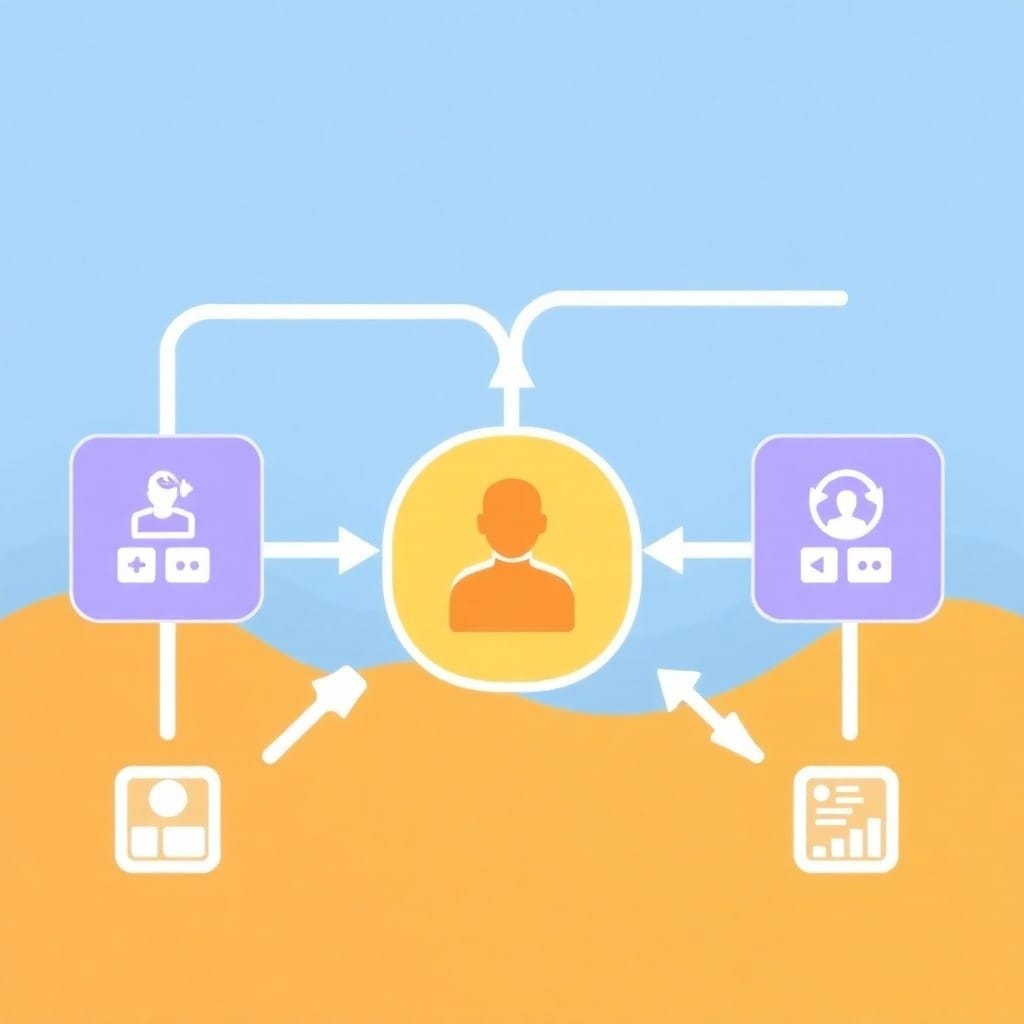The Complete Guide to Workflow Automation: Using Business Process Templates to Automate Effectively

In today's rapidly evolving business landscape, organizations are constantly seeking ways to enhance efficiency and productivity while reducing operational costs. Workflow automation has emerged as a transformative solution that allows businesses to streamline processes, eliminate manual tasks, and focus on strategic initiatives. This comprehensive guide explores how leveraging pre-built templates for common business processes can help you implement automation effectively and revolutionize your operations.
What is workflow automation and how can it transform my business processes?
Understanding the fundamentals of workflow automation
Workflow automation refers to the technology-driven approach of automating business processes by defining a sequence of tasks that were previously performed manually. At its core, workflow automation uses software to create workflows without constant human intervention, applying rules to automatically route information, documents, and tasks between people and systems. Modern workflow automation tools typically feature visual workflow builders that allow users to map out processes using intuitive drag-and-drop interfaces, making it accessible even for non-technical team members. The fundamental principle behind workflow automation is identifying repetitive tasks that follow predictable patterns and creating a digital system to handle these processes automatically, thereby reducing human error and freeing up valuable time for more complex, creative work that requires human judgment.
In the current business landscape, workflow automation has evolved beyond simple task management to encompass intelligent automation capabilities. These advanced features include artificial intelligence and machine learning components that can analyze patterns, make decisions, and continuously improve the process over time. For instance, a customer support workflow might initially route tickets based on predefined rules, but with intelligent automation, the system learns from past resolutions to better categorize and prioritize incoming requests. Process management through automation creates a more systematic approach to business operations, providing transparency into how work flows through an organization and identifying bottlenecks that might otherwise remain hidden in manual processes.
Benefits of implementing automation in your business processes
Implementing workflow automation in your business processes delivers numerous tangible benefits that directly impact your bottom line and competitive positioning. Perhaps the most immediate advantage is the dramatic increase in efficiency and productivity that comes from automating routine tasks. When repetitive tasks like data entry, document routing, and basic approvals are handled by an automation solution, employees can focus on higher-value work that requires human creativity and critical thinking. This shift not only boosts productivity but also enhances employee satisfaction by eliminating mundane aspects of their jobs. Financial benefits are equally compelling—organizations typically report significant cost savings after implementing business process automation, with some studies showing ROI within months rather than years.
Beyond efficiency gains, workflow automation dramatically improves accuracy and consistency across business operations. By removing human intervention from repetitive processes, you eliminate the errors that inevitably occur with manual data handling. This is particularly valuable in regulatory compliance scenarios where mistakes can lead to penalties. Another key benefit is the enhanced visibility and accountability that comes with automated workflows. Most workflow automation platforms include robust tracking and reporting features that provide real-time insights into process performance, bottlenecks, and completion times. This data becomes invaluable for continuous improvement efforts. Customer experience also improves significantly when processes are automated—from faster response times to more consistent service delivery across all customer touchpoints. In an evolving business environment where customer expectations continue to rise, this competitive advantage cannot be overstated.
Leading AI Automation Agency
Transform Your Business with AI-Powered Automation Solutions
Join industry leaders who have achieved up to 300% ROI through our intelligent automation strategies. Our AI automation experts will help streamline your operations, reduce costs, and drive unprecedented growth.
How workflow automation differs from traditional manual processes
Traditional manual processes rely heavily on human intervention at every stage, making them inherently prone to inconsistency, delays, and errors. These processes typically involve physical paperwork or basic digital documents passed between individuals, with status tracking often limited to spreadsheets or verbal updates. In contrast, workflow automation creates a structured digital framework where tasks move automatically between stages according to predefined rules. The differences become apparent in several key areas. Speed is perhaps the most obvious—automated workflows execute in seconds what might take hours or days through manual channels. For example, an approval workflow that previously required physically routing documents to multiple stakeholders can be completed almost instantly when automated, with parallel approvals happening simultaneously rather than sequentially.
Scalability represents another fundamental difference between manual and automated approaches. Manual processes often break down under increased volume—more customers or transactions typically require more staff. Automated workflows, however, can handle exponentially larger volumes with minimal additional resources. This scalability enables business growth without proportional increases in operational costs. Transparency also differs dramatically between the two approaches. Manual processes often create information silos where process status is known only to the current task owner. Workflow automation tools provide complete visibility into where every item stands in the process, who is responsible for the next action, and how long each step is taking. This visibility extends to historical data as well, creating a comprehensive audit trail that manual processes rarely capture effectively. As businesses face increasing pressure to operate efficiently while adapting to market changes, the limitations of manual processes become more pronounced, making the transition to workflow automation not just beneficial but necessary for competitive survival.
Which pre-built workflow templates are essential for business process automation?
Most valuable workflow templates for administrative tasks
Administrative tasks represent one of the most fertile areas for workflow automation, with numerous pre-built templates available to streamline these essential but often time-consuming processes. Document management workflows rank among the most valuable templates, automating the creation, routing, approval, and storage of various business documents. These templates typically include version control, automatic notifications, and integration with document storage systems, eliminating the chaos of email attachments and lost files. Employee onboarding represents another critical administrative workflow that benefits tremendously from automation. Pre-built onboarding templates coordinate activities across multiple departments (HR, IT, facilities, etc.), ensuring new hires receive proper equipment, access credentials, and training materials according to a consistent timeline.
Expense reporting and reimbursement workflows provide substantial efficiency gains by automating the submission, approval, and processing of business expenses. These templates typically include mobile capabilities for receipt capture, automatic policy compliance checking, and integration with accounting systems for seamless reimbursement. Leave management represents another administrative area where pre-built workflow templates offer significant value. These templates automate the request, approval, and documentation of employee time off, ensuring proper coverage and accurate record-keeping. Procurement and purchasing workflows automate the requisition, approval, vendor selection, and payment processes, often including budget checking and vendor management components. For growing organizations, these administrative workflow templates deliver immediate value by reducing the overhead associated with routine business operations while improving compliance and employee satisfaction through faster, more transparent processes.
Templates for streamlining approval processes
Approval processes exist across virtually every business function and often represent significant bottlenecks when managed manually. Pre-built approval workflow templates address this common pain point by creating structured digital pathways for requests and decisions. Budget approval templates automate the submission, routing, and authorization of financial requests based on predefined thresholds and authorities. These workflows typically include conditional logic that routes requests to appropriate decision-makers based on amount, department, or expense category. Contract approval templates streamline the often complex process of reviewing and authorizing legal agreements, incorporating parallel reviews by multiple stakeholders (legal, finance, operations) and ensuring all required approvals are secured before finalization.
Marketing material approval workflows coordinate the review and authorization of content across product, legal, brand, and executive teams, ensuring consistent messaging and compliance with regulations. These templates often include asset management components and publication scheduling once approvals are complete. Vendor and supplier approval workflows automate the vetting, qualification, and onboarding of new business partners, ensuring consistent evaluation and proper documentation. Invoice approval templates streamline the verification and payment authorization process, often including three-way matching (purchase order, receiving document, invoice) and exception handling for discrepancies. What makes these approval workflow templates particularly valuable is their adaptability to specific business needs while maintaining the core approval structure that ensures proper governance. By implementing these templates, organizations can dramatically reduce decision delays while maintaining appropriate controls and creating comprehensive audit trails of approval decisions.
Customer service workflow automation templates
Customer service represents a critical business function where workflow automation delivers exceptional value through improved response times, consistency, and resolution rates. Case management workflow templates form the foundation of automated customer support, tracking issues from initial contact through resolution while ensuring proper routing, escalation, and follow-up. These templates typically include SLA (Service Level Agreement) monitoring, automatic notifications, and integration with communication channels. Customer onboarding workflows automate the process of welcoming and setting up new customers, coordinating activities across sales, implementation, training, and account management teams to ensure a smooth transition from prospect to active customer.
Return and refund processing workflows automate the often complex sequence of approvals and actions required when customers request returns, providing consistent application of policies while maintaining appropriate controls. Complaint management templates streamline the intake, categorization, assignment, and resolution of customer issues, often including escalation paths for complex problems and reporting functions to identify recurring problems. Customer feedback collection and processing workflows automate the gathering, analysis, and distribution of customer input, helping organizations systematically incorporate this valuable information into product and service improvements. These customer support workflow templates deliver particular value in maintaining service quality as businesses scale, ensuring that increasing customer volume doesn't result in degraded service experience. By implementing these pre-built templates for common customer interactions, organizations can dramatically improve satisfaction while optimizing the efficiency of their support teams.
How to choose the right workflow automation tool for your specific business needs?
Key features to look for in automation platforms
Selecting the right workflow automation platform requires careful evaluation of several key features that will determine its effectiveness for your specific business needs. User experience should be a primary consideration—look for platforms with intuitive visual workflow builders that allow business users to create workflows without extensive technical knowledge. The best workflow tools offer drag-and-drop interfaces with pre-built components that can be assembled into sophisticated processes. Integration capabilities represent another critical feature, as the automation solution must connect seamlessly with your existing business systems. Evaluate platforms based on their native connectors to popular business applications, API availability, and support for middleware tools that can bridge connection gaps.
Mobile functionality has become increasingly important as work extends beyond traditional office environments. Look for automation platforms that offer responsive interfaces and native mobile apps, allowing users to participate in workflows from anywhere. Security features should be thoroughly evaluated, including role-based access controls, data encryption, compliance certifications, and audit trail capabilities. Reporting and analytics capabilities provide critical insights into process performance and opportunities for optimization. The most effective workflow automation tools offer customizable dashboards, performance metrics, and the ability to identify bottlenecks. Scalability considerations should include both the volume of workflows the platform can handle and the complexity of processes it can support. Evaluate whether the platform can grow with your organization and accommodate increasingly sophisticated automation requirements as your business evolves. Finally, consider the availability of pre-built templates for common business processes, as these can dramatically accelerate implementation and provide best-practice frameworks for your automation initiatives.
Comparing popular workflow automation tools in the market
The workflow automation market offers numerous platforms with varying strengths and specializations. Enterprise-focused solutions like ServiceNow and Pega provide comprehensive process automation capabilities with robust governance features, making them suitable for large organizations with complex requirements. These platforms offer extensive customization options but typically require significant implementation resources. Mid-market solutions like Monday.com, Asana, and ClickUp combine workflow automation with project management features, providing an accessible entry point for organizations seeking to automate team-based processes. These platforms offer intuitive interfaces and quick implementation but may lack the depth of specialized workflow features found in dedicated automation tools.
Industry-specific workflow automation tools target particular sectors with pre-configured templates and compliance features relevant to those domains. For example, healthcare-focused platforms include HIPAA compliance features, while finance-oriented solutions incorporate regulatory checks specific to banking and investment activities. Low-code/no-code platforms like Zapier, Integromat, and Microsoft Power Automate democratize automation by enabling non-technical users to create workflows without coding. These platforms excel at connecting different applications and automating data flows between them, though they may have limitations for complex process logic. When comparing options, consider not just current requirements but how your automation needs will evolve. Evaluate vendors based on their innovation roadmap, community support, and ability to incorporate emerging technologies like artificial intelligence into their workflow capabilities. The ideal workflow automation tool balances ease of use with powerful functionality while providing the specific features most relevant to your business operations.
Scalability considerations for growing businesses
For growing businesses, choosing a workflow automation platform that can scale effectively is paramount to long-term success. Volume scalability represents the most obvious consideration—as your business grows, the platform must handle increasing numbers of workflow instances, users, and data without performance degradation. Look for platforms that explicitly state their handling capacity and offer tier upgrades as needs expand. Equally important is complexity scalability—the ability to evolve from simple workflows to more sophisticated business process automation as your organization matures. The ideal platform allows you to start with basic workflows but supports advanced features like conditional branching, parallel processing, and exception handling as your automation sophistication increases.
Cost scalability matters significantly for growing businesses. Evaluate not just current pricing but how costs will increase as your usage expands. Some platforms charge by user count, others by workflow volume, and still others by feature tiers. Understanding this cost progression helps avoid unpleasant surprises as you scale. Integration scalability considers how the automation platform connects with an expanding ecosystem of business applications. As your technology stack grows, the automation tool should facilitate rather than hinder these connections. Finally, consider administrative scalability—as your organization implements more workflows across more departments, the platform should provide appropriate governance, including template libraries, approval mechanisms for new workflows, and monitoring capabilities. The most successful growing businesses select workflow automation tools that balance immediate needs with future requirements, ensuring the platform remains a valuable asset rather than a limitation as the organization evolves.
What are the best strategies to automate routine tasks and approval processes?
Identifying tasks suitable for automation
The journey toward effective workflow automation begins with systematically identifying which tasks and processes are most suitable for automation. Repetitive tasks with consistent patterns represent the most obvious candidates—processes that follow the same steps with minimal variation are easily translated into automated workflows. Data-heavy processes that involve transferring information between systems or performing calculations based on established rules also offer excellent automation opportunities. Begin by documenting current processes in detail, noting frequency, duration, error rates, and the number of people involved. This process mapping creates visibility into which activities consume disproportionate resources relative to their strategic value.
When evaluating automation candidates, look for processes with clearly defined triggers and endpoints, as these boundaries make automation implementation more straightforward. Approval processes that follow consistent rules are particularly well-suited for automation, especially when they involve multiple stakeholders or sequential steps. Prioritize automation opportunities based on potential business impact—consider factors like time savings, error reduction, compliance improvements, and customer experience enhancement. The most successful automation initiatives often begin with high-volume, low-complexity processes that deliver quick wins and build organizational momentum. Remember that not all tasks are suitable for complete automation; in many cases, the optimal approach involves automating routine portions while maintaining human involvement for exceptions or judgment-requiring elements. This strategic identification of automation candidates ensures your resources target the processes that will deliver maximum return on your automation investment.
Implementing effective approval workflow templates
Approval processes exist throughout organizations and often represent significant bottlenecks when managed manually. Implementing effective approval workflow templates requires careful planning and configuration to balance efficiency with appropriate controls. Begin by clearly defining approval policies, including authorization levels, delegation rules, and exception handling procedures. Document who can approve what, under which circumstances, and what happens when standard approvers are unavailable. This policy foundation ensures your automated approval workflow accurately reflects organizational governance requirements. When configuring approval templates, incorporate parallel approval paths where appropriate to prevent sequential bottlenecks—multiple stakeholders can review simultaneously rather than passing the request from one to another.
Effective approval workflow templates include robust notification systems that alert approvers to pending requests and remind them of items awaiting action. These notifications should be configurable in terms of timing, frequency, and delivery channel (email, mobile, in-app) to accommodate different work styles. Escalation paths represent another critical element of approval automation—if approvals aren't completed within defined timeframes, the workflow should automatically route to alternative decision-makers. For complex approval scenarios, implement conditional routing that directs requests to different approvers based on specific criteria like amount, department, or risk level. Finally, ensure your approval workflows include comprehensive tracking and reporting capabilities that provide visibility into approval status, cycle times, and bottlenecks. This performance data helps continuously refine your approval processes while providing valuable audit trails for compliance purposes. By thoughtfully implementing these approval workflow templates, organizations can dramatically reduce decision delays while maintaining appropriate governance controls.
Measuring success of your process automation efforts
Establishing meaningful metrics to evaluate workflow automation success is essential for justifying investments and guiding continuous improvement. Time savings typically represents the most immediately measurable benefit—compare process completion times before and after automation to quantify efficiency gains. This measurement should include both average processing time and variability reduction, as consistent performance often delivers as much value as raw speed. Error reduction provides another quantifiable metric—track how automation has decreased mistakes, exceptions, and rework compared to manual processing. For customer-facing processes, measure improvements in response times, resolution rates, and satisfaction scores that can be attributed to automation.
Beyond these operational metrics, evaluate financial impacts including cost savings from reduced manual effort, error remediation, and accelerated processes. Calculate return on investment by comparing these savings against implementation and ongoing platform costs. Adoption metrics help gauge organizational acceptance—track how many departments have implemented workflows and how many processes have been automated.
Q: How can I automate processes in my business effectively using templates?
A: To effectively automate processes using templates, start by identifying repetitive tasks that consume significant time. Choose a workflow automation software that offers a library of pre-built workflows relevant to your industry. Customize these templates to suit specific business needs rather than building from scratch. Implement the solution gradually, testing each workflow before full deployment. Most modern platforms allow you to create dynamic workflows in minutes with drag-and-drop interfaces, requiring minimal technical skills. The key is selecting templates that align with your existing business workflow while providing flexibility for future growth.
Q: What are the benefits of using customizable workflows for business automation?
A: Customizable workflows deliver numerous advantages for business automation. They allow you to tailor solutions precisely to your organization's unique requirements rather than forcing you to adapt to rigid systems. These flexible templates serve as starting points that can be modified to accommodate your specific business rules and procedures. Benefits include faster implementation time, reduced development costs, streamlined business operations, and the ability to quickly adjust as your processes evolve. Additionally, customized workflow templates typically incorporate best practices from your industry, helping optimize business processes from the start.
Q: Which common business processes can be improved through workflow automation solutions?
A: Numerous business processes benefit from workflow automation solutions. Human resources functions like the employee onboarding process and time-off requests can be streamlined significantly. Financial processes including expense approvals, purchase orders, and invoice processing become more efficient. Customer service workflows like complaint handling and support ticket routing are dramatically improved. Other areas include document approval cycles, project management tasks, sales pipelines, vendor management, compliance documentation, and quality assurance protocols. The most effective approach is automating repetitive tasks that follow consistent patterns and require multiple approvals or handoffs between teams.
Q: How difficult is it to implement workflow automation software in an established business?
A: Implementing workflow automation software in an established business is typically less challenging than many anticipate, especially when using template-based solutions. Modern platforms offer user-friendly interfaces designed for business users, not just IT professionals. The integration process can be approached incrementally, starting with simple processes before tackling complex workflows. The key challenges usually involve change management rather than technical hurdles. Resistance can be minimized by involving end-users in the selection process, providing adequate training, and demonstrating early wins. Most contemporary workflow solutions offer pre-built connectors to popular business applications, further simplifying implementation.
Q: What features should I look for in a quality workflow automation solution?
A: A quality workflow automation solution should include several essential features. Look for a comprehensive library of pre-built workflows that can be easily customized. Ensure the platform offers visual process designers with drag-and-drop functionality for creating and modifying workflows in minutes. Integration capabilities with your existing software ecosystem are crucial. Robust reporting tools help monitor performance and identify bottlenecks. Mobile accessibility enables work from anywhere. Advanced solutions also offer features like document generation, electronic signatures, form builders, and automated notifications. Finally, scalability is vital—choose a solution that can handle increasingly complex workflows as your automation initiatives mature.
Q: How can workflow templates help with automating complex tasks in my organization?
A: Workflow templates excel at automating complex tasks by breaking them down into manageable, logical sequences. They encode best practices and logical decision points that might be overlooked when building processes from scratch. For complex approval chains, conditional logic, or multi-department coordination, templates provide proven frameworks that can be adapted to your specific requirements. They help ensure compliance with established procedures while maintaining flexibility. Templates also make the automation of complex workflows more accessible to non-technical users by providing a starting structure. This approach significantly reduces the time and expertise needed to implement sophisticated business automation compared to custom development.
Q: What ROI can businesses expect when implementing customized workflow automation?
A: Businesses implementing customized workflow automation typically see impressive ROI across multiple dimensions. Time savings of 70-80% for routine processes are common. Error rates often decrease by 30-50% by eliminating manual data entry and ensuring consistent application of business rules. Employee satisfaction improves as staff focus on meaningful work instead of repetitive tasks. Customer experience enhances through faster response times and consistent service. Organizations typically recoup their investment within 6-12 months, with ongoing benefits increasing as more processes are automated. Beyond these direct benefits, workflow automation provides valuable data for continually optimizing business processes and identifying further improvement opportunities.
Q: How can workflow automation help with the employee onboarding process?
A: Workflow automation transforms the employee onboarding process by creating a consistent, efficient experience while reducing administrative burden. Automated workflows can trigger sequences of tasks when a new hire is entered into the system—from generating offer letters to scheduling orientation sessions, assigning equipment, setting up accounts, and distributing training materials. Automated reminders ensure nothing falls through the cracks. The system can collect electronic signatures on required documents and automatically route them to appropriate departments. Managers receive progress updates without manual follow-up. This comprehensive approach reduces onboarding time by up to 70%, minimizes errors in documentation, ensures compliance with policies, and creates a more positive first impression for new employees.



